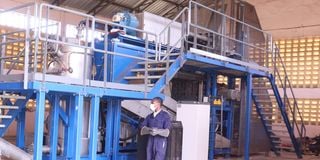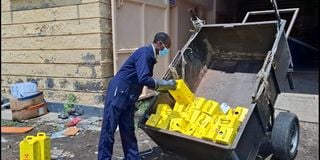Ever wonder where PGH's medical waste goes? Here's how its handled

The in-house healthcare microwave incinerator and a waste shredding unit at PGH on August 5,2025.
Have you ever wondered what happens to the syringe after the doctor gives you an injection? Or the gloves a nurse removes after dressing a wound?
These items are often part of a complex chain of medical waste that must be handled with care to protect patients, health workers, and the wider community.
At Nakuru’s Provincial General Hospital (PGH), the largest teaching and referral facility in the county, there is a structured system that the hospital operates; an in-house healthcare microwave incinerator and a waste shredding unit, where medical waste is temporarily stored, carefully segregated, shredded, sterilized, and ultimately disposed of through regulated processes.
Francis Kuria, a Biomedical Engineer at PGH, says the waste is collected four times a day from different parts of the hospital, from wards, the morgue, and theatres.
“All the waste that comes here is usually pre-sorted into three types of bin liners,” explains Kuria.
“The red liners contain highly infectious waste like used gloves, syringes, and blood-stained materials; the yellow ones are for infectious or potentially infectious waste; and the black liners hold general and food waste, which is often sorted before being fed into the machine for shredding.”
The waste, typically weighing around 150 kilograms per batch, is first fed into a loading hopper before passing through a primary shredder that reduces it into smaller fragments measuring 2–3 centimeters.
It is then further processed through a secondary shredder for temporary holding.

Francis Kuria, a Biomedical Engineer at PGH, loads a cart with segregated waste syringes (in safety boxes) which is often taken to the incineration facility, on August 5,2025.
From there, the shredded material enters the treatment chamber, undergoing thermal sterilization at temperatures ranging from 0°C to 100°C, with water playing a critical role in neutralizing pathogens.
Once partially sterilized, the waste is transferred into a holding tank (microwave) with a capacity of 250 kilograms.
Here, it undergoes a second, more intensive round of sterilization, this time at higher temperatures exceeding 100°C.
The process results in the release of condensed steam and sterilized output, ensuring the waste is rendered safe before final disposal.
“The electricity-powered machine, in the facility run by about six employees (five operators and one engineer), processes 1000kg (one ton) of medical waste per day," says Kuria, adding that other waste like syringes (in safety boxes) are often taken to the incineration facility, whereas the anatomical/pathological waste is disposed of differently.
Gerald Maina, the Head of Promotive and Preventive Health Services, says the facility was commissioned in 2018, and it was to assist the facility in managing its infectious waste.
“As our hospital grew, increased wards and human traffic, we saw the need to manage our waste in an environmentally friendly way since it meant generating more waste,” he says.
The unit is only currently at PGH, while other facilities are currently using incineration.
The county has an understanding with private clinics and hospitals, which helps them offset their waste to ensure that medical waste is not discharged or disposed of in dumpsites, to also protect the waste pickers.


